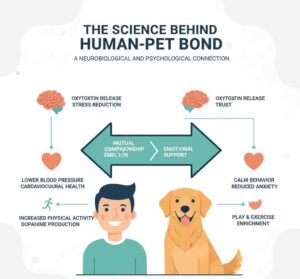By Dr. Eleanor Vance, Animal Psychology Specialist for Paws & Hearts
For centuries, humans have welcomed animals into their homes and hearts. But what is the compelling force behind this ancient bond? As an animal psychology specialist, I’m often asked to justify this profound connection through data and research. The answer, however, lies in a powerful synergy of biological, psychological, and social factors that reveal pet ownership isn’t just a luxury—it’s a fundamental component of human wellness.
Table of Contents
-
The Biological Blueprint for Bonding
1. The Biological Blueprint for Bonding
Our connection with animals is written in our biology. When we interact positively with a pet, our bodies undergo measurable, beneficial changes. The simple act of petting a dog or cat can trigger a cascade of neurochemical events.
The Oxytocin Loop: Positive interaction with a pet stimulates the release of oxytocin, often called the “love hormone.” This hormone enhances feelings of trust, empathy, and bonding in both you and your pet. Simultaneously, cortisol, a primary stress hormone, decreases. This powerful one-two punch lowers blood pressure, reduces heart rate, and mitigates the physical effects of stress.
The Activation Effect: Pets, particularly dogs, encourage physical activity through walks and play. This consistent routine of moderate activity not only improves cardiovascular health but also releases endorphins, further boosting mood and creating a positive feedback loop that benefits both species.
Q: Is the “Oxytocin Loop” a proven scientific phenomenon?
A: Absolutely. Multiple peer-reviewed studies using blood samples from both humans and their dogs after positive interactions have confirmed a synchronized increase in oxytocin levels. This demonstrates that the bond is not just emotional, but a tangible, biochemical partnership.
2. The Psychological Pathway to Better Mental Health
Beyond biology, pets provide irreplaceable psychological scaffolding. They fulfill core human emotional needs that are sometimes difficult to meet through human relationships alone.
Unconditional Positive Regard: A pet offers a non-judgmental presence. They do not care about your career, appearance, or social status. This provides a safe space for emotional expression, buffering against feelings of loneliness and social anxiety. For individuals struggling with trust or trauma, a pet can serve as a bridge to rebuilding secure attachments.
The Power of Purpose and Routine: Caring for another living being instills a sense of responsibility and purpose. The required routine—feeding, walking, grooming—provides structure to the day, which is a cornerstone of managing conditions like depression and anxiety. This routine shifts focus outward, breaking cycles of rumination and negative self-talk.
Q: Can a pet truly replace human connection for someone who is lonely?
A: While a pet is not a substitute for human community, it is a powerful complement. It alleviates the sharp edges of loneliness by providing consistent companionship and tactile comfort, often making it easier for individuals to then engage in social situations, as the pet can act as a social catalyst.
3. A Step-by-Step Guide to Mutually Beneficial Pet Ownership
Embarking on pet ownership should be a deliberate decision, not an impulsive one. Follow these steps to ensure a relationship that is healthy and rewarding for both of you.
Step 1: Honest Self-Assessment
Before any adoption, conduct a rigorous self-audit. Evaluate your lifestyle, energy level, living space, financial resources, and long-term goals. A high-energy retriever may not suit a sedentary apartment dweller, just as an independent cat might be perfect for a busy professional.
Step 2: Research and Matchmaking
Choose a pet based on compatibility, not just aesthetics. Research different species and breeds, focusing on their inherent temperament, exercise needs, and grooming requirements. The goal is to find an animal whose natural instincts align with your personality and capacity.
Step 3: Focus on Positive Reinforcement
Build trust and encourage desired behaviors through reward-based training. Using treats, praise, and play strengthens your bond and creates a common language. Avoid punitive methods, which damage trust and can create behavioral issues.
Step 4: Prioritize Mutual Enrichment
A stimulated pet is a happy pet. Provide toys, puzzles, and novel experiences to engage their minds. Likewise, fully immerse yourself in the relationship. The mental health benefits are greatest when you are actively present and engaged during your interactions.
Q: I have a busy schedule. Is it unfair to get a pet?
A: Not necessarily. The key is matching the pet to your schedule. Some pets, like certain cat breeds or small animals, are more independent. For any pet, the quality and consistency of the time you do dedicate are far more critical than the sheer quantity of hours.

4. Navigating Common Misconceptions
Several myths about pet ownership can lead to mismatches and disappointment. Let’s clarify the most common ones.
Misconception 1: “Pets are for cuddling, not for work.”
Reality: While affection is a benefit, pet ownership is a responsibility. It requires a commitment to training, healthcare, and meeting the animal’s species-specific needs, which may not always be convenient.
Misconception 2: “Any pet will automatically fix my mental health.”
Reality: Pets are a supportive tool, not a cure. The relationship requires active participation to be therapeutic. Furthermore, the stress of an poorly-matched pet or one with behavioral problems can outweigh the benefits.
Misconception 3: “My pet doesn’t need training if it’s just a house pet.”
Reality: All pets benefit from structure and training. It is not about imposing dominance but about clear communication, which prevents frustration and behavioral problems, making coexistence safer and more harmonious for everyone.
Q: My child promised to take care of the pet, but now I’m doing all the work. Is this common?
A: This is one of the most frequent scenarios. Ultimately, the adult is always the primary responsible party. A pet can teach a child responsibility, but it is unrealistic to expect a child to manage it entirely. View the pet as a family commitment that you oversee.
5. The Verdict: More Than Just a Pet
The human need for connection with animals is deep-seated and empirically validated. Pets are not passive recipients of our care; they are active participants in a symbiotic relationship that nourishes our biological, psychological, and social well-being. They quiet our stress responses, anchor us in the present moment, and provide a unique form of companionship that is both simple and profound.
By understanding the science behind the bond and approaching ownership with intentionality, we don’t just save an animal—we invite a partner in wellness into our lives, creating a bond that truly benefits both paws and hearts.



